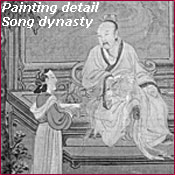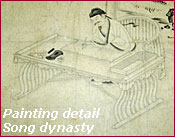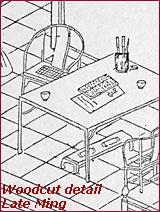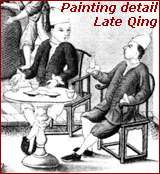 Round-back armchairs emerged simultaneously with other highback chairs during the Tang and Song dynasties. Its origins are suggested by the ancient, curved armrests with three short legs that were used on ground mats and later placed on platforms. Song texts also refer to armrests made of bent wood or bamboo.
Round-back armchairs emerged simultaneously with other highback chairs during the Tang and Song dynasties. Its origins are suggested by the ancient, curved armrests with three short legs that were used on ground mats and later placed on platforms. Song texts also refer to armrests made of bent wood or bamboo.
 By the Ming dynasty, it developed into one of the most graceful chair forms of traditional furniture. Its rounded backrest and smooth, downward sloping armrest are exceptionally comfortable for supporting the elbows and arms.
By the Ming dynasty, it developed into one of the most graceful chair forms of traditional furniture. Its rounded backrest and smooth, downward sloping armrest are exceptionally comfortable for supporting the elbows and arms.

 In the West, the term ‘horseshoe armchair’ describes of the shape of the armrest. An illustration of a round-back chair appears in the late Ming encyclopedia, Sancai tuhui (Pictorial Encyclopedia of Heaven, Earth and Man) along with the caption ‘yuanyi’ (round chair). The modern Chinese preference is quanyi.
In the West, the term ‘horseshoe armchair’ describes of the shape of the armrest. An illustration of a round-back chair appears in the late Ming encyclopedia, Sancai tuhui (Pictorial Encyclopedia of Heaven, Earth and Man) along with the caption ‘yuanyi’ (round chair). The modern Chinese preference is quanyi.  The round-back chair exhibits the artistic aesthetic called ‘roundness’ or ‘wholeness’ (yuanhun), which is achieved by the composition of curvilinear armrest and side posts, which appear to cradle a spherical void. With its relatively cubic base, the round-back chair is also a three dimensional representation of the Chinese cosmological concept of ‘round heaven and square earth’ (tianyuan difang). Frame members shaped with a round section above and a square section below also express this idea.
The round-back chair exhibits the artistic aesthetic called ‘roundness’ or ‘wholeness’ (yuanhun), which is achieved by the composition of curvilinear armrest and side posts, which appear to cradle a spherical void. With its relatively cubic base, the round-back chair is also a three dimensional representation of the Chinese cosmological concept of ‘round heaven and square earth’ (tianyuan difang). Frame members shaped with a round section above and a square section below also express this idea.